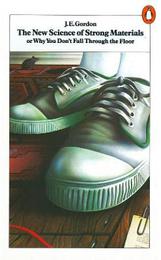
|
The New Science of Strong Materials: Or Why You Don't Fall Through the Floor
Paperback / softback
Main Details
| Title |
The New Science of Strong Materials: Or Why You Don't Fall Through the Floor
|
| Authors and Contributors |
By (author) J E Gordon
|
| Physical Properties |
| Format:Paperback / softback | | Pages:288 | | Dimensions(mm): Height 181,Width 111 |
|
| Category/Genre | Materials science |
|---|
| ISBN/Barcode |
9780140135978
|
| Classifications | Dewey:620.112 |
|---|
| Audience | |
|---|
|
Publishing Details |
| Publisher |
Penguin Books Ltd
|
| Imprint |
Penguin Books Ltd
|
| Publication Date |
28 March 1991 |
| Publication Country |
United Kingdom
|
Description
Why isn't wood weaker that it is? Why isn't steel stronger? Why does glass sometimes shatter and sometimes bend like spring? Why do ships break in half? What is a liquid and is treacle one? All these are questions about the nature of materials. All of them are vital to engineers but also fascinating as scientific problems. During the 250 years up to the 1920s and 1930s they had been answered largely by seeing how materials behaved in practice. But materials continued to do things that they "ought" not to have done. Only in the last 40 years have these questions begun to be answered by a new approach. Material scientists have started to look more deeply into the make-up of materials. They have found many surprises; above all, perhaps, that how a material behaves depends on how perfectly - or imperfectly - its atoms are arranged. Using both SI and imperial units, Professor Gordon's account of material science is a demonstration of the sometimes curious and entertaining ways in which scientists isolate and solve problems.
Author Biography
James Edward Gordon was born in 1913. He took a degree in naval architecture at Glasgow University and worked in wood and steel shipyards, intending to design sailing ships. On the outbreak of the Second World War he moved to the Royal Aircraft Establishment at Farnborough, where he worked on wooden aircraft, plastics and unorthodox materials of all kinds. He designed the sailing rescue dinghies carried at one time by most bomber aircraft. He later became head of the plastic structures sections at Farnborough and developed a method of construction in reinforced plastics which is now used for a number of purpose in aircraft and rockets. For several frustrating years he worked in industry on the strength of glass and the growth of strong 'whisker' crystals. In 1962 he returned to government service as superintendent of an experimental branch at Waltham Abbey concerned with research and development of entirely new structural materials, most of which were based on 'whiskers'. He was Industrial Fellow Commoner at Churchill College, Cambridge, and became Professor of Materials Technology at the University of Reading, where he was later Professor Emeritus. He was awarded the British Silver Medal of the Royal Aeronautical Society for work on aircraft plastics and also the Griffith Medal of the Materials Science Club for contributions to material science. His book, Structures or Why Things Don't Fall Down, is also published in Penguin. Professor Gordon died in 1998. In its obituary The Times wrote of him that he was 'one of the founders of materials science' and that he wrote 'two books of outstanding literary quality ... at once entertaining and informative, providing absorbing interest for both expert and student'.
|